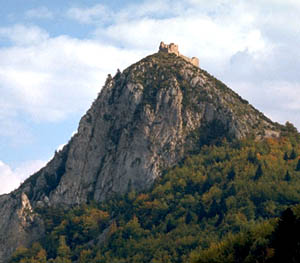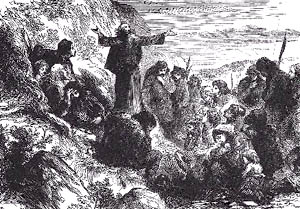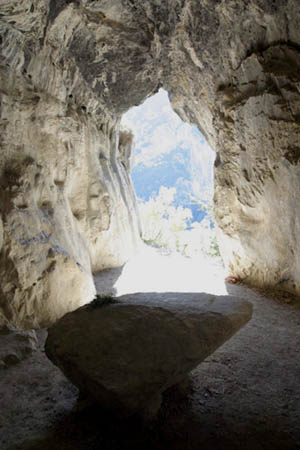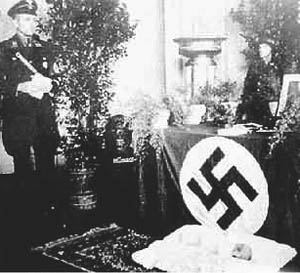 |
Secret Forces
Nazism, a Gnostic-Manichean Sect - Part II
The Mission of Otto Rahn at Montségur
Cunha Alvarenga
The Pantheism characteristic of Gnosis appeared in the Christian Era under different disguises. In the first period of the Church History we see the so-called Indo-Hellenistic heresies that deny the Incarnation of the Word, at times rejecting the Divinity of Our Savior, at time His Humanity.

Montsegur Castle, atop Mount Pog, was one of the last Cathar strongholds |
Manichaeism was the principal Gnostic group. It maintained a double Pantheism: a Pantheism of spirit, which emanates from the good; and a Pantheism of matter, which emanates from the evil. Both were considered necessary and evolved through the clash of theses and antitheses. The followers of this doctrine repudiated marriage, considering it evil since it propagates matter; they also rejected property, the ownership of material goods, as a bad attachment to matter, rejected as evil.
From this period are also the Neo-Platonics of the Alexandrian School, the Montanists, the Docetists, the Anti-Trinitarians, the Sabellians, and the Patripassionists. They were followed by other branches: Arianism, Pelagianism, Nestorianism, Eutheism, Monophisism and Monotheletism.
Nestorianism opened a new heretical line, making sophisms about the relations of the natures of Our Lord Jesus Christ. The unity of His Person started to be attacked, and the error that Jesus Christ is two distinct persons spread. In the wake of Nestorianism came Euthicheism, which affirmed that His human nature had been absorbed by His Divinity in such a way that the body of Our Lord was human as far as the form and exterior appearance were concerned, but not in its substance. Monophisism came next, admitting only one nature in Our Lord: the divine. And then Monotheletism, admitting only one will in Jesus Christ: the divine.
These theological fantasies were duly fulminated by the following decree of the Fourth Council of Chalcedon in 451:
“According to the teaching of the Holy Fathers, we teach with one voice that the Son [of God] and Our Lord Jesus Christ is to be confessed as the one and the same [Person], that he is perfect in his divinity and perfect in his humanity, true God and true man, being composed of a rational soul and [human] body, consubstantial with the Father as touching his Godhead, and consubstantial with us as touching his manhood; like us in all things but sin; begotten of his Father before the worlds according to his Godhead; but in these last days for us men and for our salvation born of the Virgin Mary, the Mother of God, according to his manhood. This one and the same Jesus Christ, the only-begotten Son must be confessed to be in two natures, without confusion, change, division, or separation, and without the distinction of natures being taken away by such union, but rather the peculiar property of each nature being preserved and being united in one Person and subsistence; not separated or divided into two persons, but one and the same Son and only-begotten, God the Word, Our Lord Jesus Christ, as the Prophets of old time have spoken concerning him, and as the Lord Jesus Christ has taught us, and as the Creed of the Fathers has delivered to us.”
This clear formula resolved the question of the nature of Our Lord Jesus Christ in the public arena of the Church for a while. However, we see that from time to time the old hydra of the Gnostic error returns in History under new appearances. Always combated, never extinguished, Gnosis continues its underground march century after century.

Adherents of Catharism would meet in the hillsides, caves, and fortresses like Montsegur |
In the Middle Ages it infiltrated Christendom under the name of Catharism or the Albigensian heresy, establishing one of its most powerful poles in Southern France, in the Languedoc,
This Neo-Manichaeist Catharism was exterminated in France by means of a Crusade preached by the Church to stop the devastation the error was causing among the faithful. French historian Jean Guiraud describes it:
“It is evident, first at all, that the public power was as apprehensive – and perhaps even more – as the Church about the existence and development of heresies. The heresies that most concerned it were not the pure theological ones. Indeed, we do not see the civil authorities troubled over Berenger‘s negation of the dogma of Transubstantiation. The ones that disturbed the civil power were those that mixed theological errors with anarchist and anti-social doctrines. Thus, we find Princes – even excommunicated ones – who persecuted such heresies as strongly as the Popes, because their possible triumph would represent the ‘ruin of the homeland,’ according to the expression of Robert the Pious” (Jean Guiraud, L’Inquisition Médievale, Paris: Bernard Grasset, 1928, p. 81).
At the decline the Middle Ages, we again see the Gnostic error coming to the surface, although carefully and under cover. The Gnostic influence can be noticed in precursors of the Protestant heresy such as Wycliffe and John Hus, as well as in Luther himself. Gnostic was also the foundation of Cromwell’s Puritanism in England, for example. Later in the 18th and 19th centuries, almost everywhere one can note the presence of a huge subterraneous movement with a clear Gnostic Manichean, magic and occult tendency.
The strange mission of Otto Rahn at Montségur

An initiation site in a cave near Montsegur |
For some people it can appear surprising that modern Neo-Pagan currents such as Nazism are inundated with Gnosis and the occult. In their book Morning of the Magicians [Le Matin des Magiciens], authors Louis Pauwels and Jacques Bergier lift the tip of the veil that shrouds this mystery, although in a novelistic way. It encourages man to look at reality with "awakened eyes," and deals with the notion of the “perfected man,” quite close to the ideal of Gnosis. It also proposes that Nazism is the product of an old occult Gnostic doctrine.
In the book Hitler and the Cathar Tradition [Hitler et la Tradition Cathare, Paris: Robert Lafont, 1971], author Jean Michel Angebert presents impressive documentation about the Gnostic and occult origins of the national socialist Third Reich.
An introductory chapter of this book titled “Otto Rahn and the Crusade against the Grail,” reports that in the summer of 1931, the young German researcher Otto Wilhelm Rahn appeared in the Pyrenees region of Southern France on a mysterious mission. Near the city of Lavelanet he spent a long time at the ruins of the Fortress of Montségur, the famous Montsalvat of the Provençal troubadours. The anti-Catholic author describes it as “the Tabor of the Western Cathars and the last refuge of the Albigensian heresy, one of those high places where the Spirit blows. Since time immemorial, the Pog, the high rock formation over which the castle was built, has been considered a sacred site” (p. 27).
The singular characteristics of the fortress have led persons to believe that it was not built for military purposes, but rather following a plan of religious architecture. “It is therefore licit to think, and the whole Albigensian epopee confirms it,” opines the author, “that Montségur [its name means safe mountain] was a temple dedicated to a cult, a sacred place that could offer a fearless resistance in case of an invasion,” (p. 29).

Otto Rahn, above left, went to Montsegur on a secret mission to search for the Cathar inheritance |
By the way, other castles in the Provence have similar characteristics, and some of them were occupied by Albigensians. In fact, researchers have discovered around 40 subterraneous edifices of the 11th and 12th centuries in Southern France, each of them with a chapel room and altar, all converging toward a single point. Angebert notes: “After a profound study of those buildings, Henri Coltel became convinced that they were not simply refuges, but rather places of cult where the Cathars, even before the persecutions, carried out initiation ceremonies” (p. 29).
Otto Rahn passed three months in the area of Lavelanet; in 1937 he returned for a shorter stay. Between these two visits, he published the book The Crusade against the Grail [Kreuzug gegen den Gral], which had great success in Germany. In it Rahn placed the mysterious Holy Grail in Montségur, and affirmed that the Cathars were the last ones to guard it.
What is curious is the reason Rahn made those two secret trips to study the ruins of Montségur: it was a mission he had received from Alfred Rosenberg, the notorious theoretician of Nazism.
Continued

Posted March 6, 2008
Translated from Catolicismo, September 1971
History | Home | Books
| CDs | Search
| Contact Us | Donate

© 2002-
Tradition in Action, Inc. All Rights Reserved
|
 |

|
|